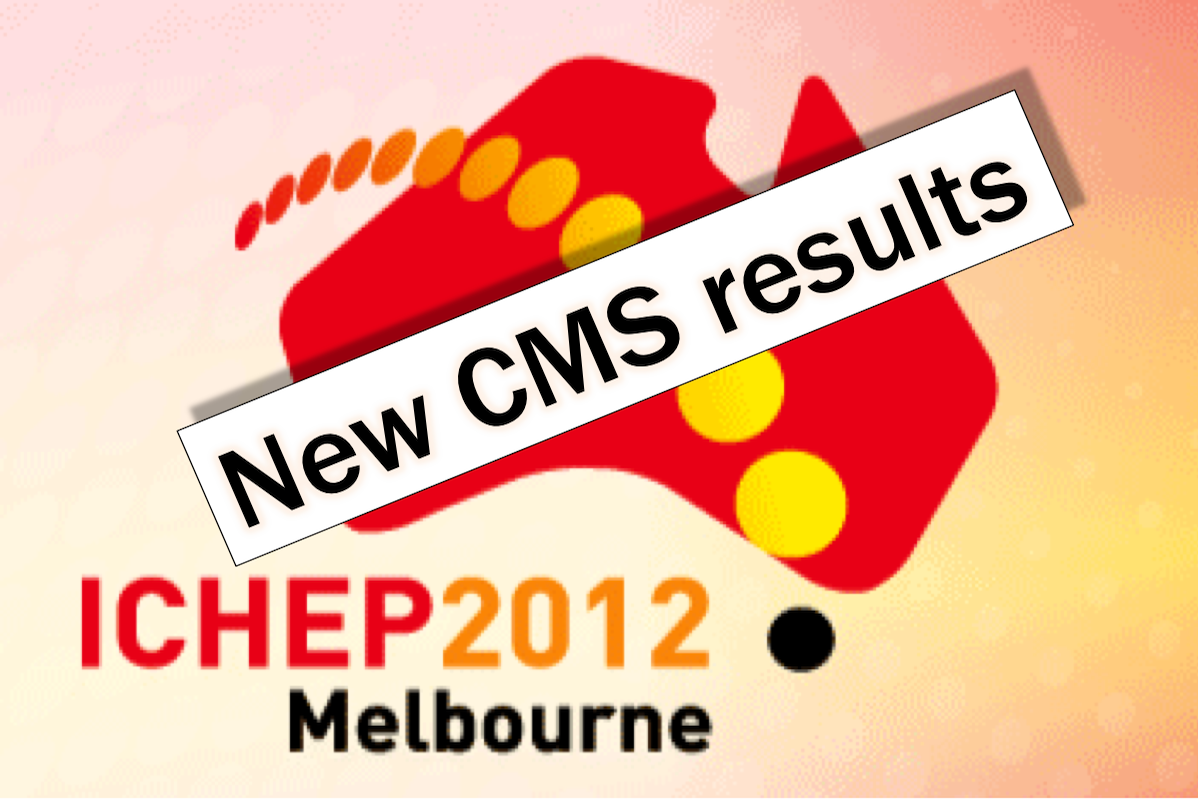
*** draft *** draft *** draft ***
| CMS contributions | Media enquiries: CERN Press Office |
This page shows new CMS results presented at the International Conference on High-Energy Physics (ICHEP) during 4—11 July 2012 in Melbourne, including the searches for the Higgs boson, other new physics, and Standard Model measurements.
The results are based on up to XXX fb−1 (inverse femtobarns[1]) of proton-proton data recorded at a collision energy of 7 TeV in 2011 and up to XXX fb−1 at 8 TeV in 2012 (details vary for different results).
Search for the Higgs Boson
For the latest CMS Higgs results see the official CMS Higgs Statement ] and [ Presentation ]
Other selected CMS results
*** draft *** table of selected highlights ("high priority analyses")
See also Full ICHEP agenda --- RELOAD PAGE FOR LATEST RESULTS --- Click column title to sort column
| Group | Date | Title (Speaker) | Notes |
|---|---|---|---|
| Higgs | xxx July | H → gg (John Doe) | CMS-PAS-HIG-12-015 |
| Higgs | xxx July | H → ZZ(4l) (John Doe) | CMS-PAS-HIG-12-016 |
| Higgs | xxx July | H → WW(2l2n) (Jane Dee) | CMS-PAS-HIG-12-017 |
| Higgs | xxx July | H → tt (John Doe) | CMS-PAS-HIG-12-018 |
| Higgs | xxx July | VH → Vbb (Jane Dee) | CMS-PAS-HIG-12-019 |
| Higgs | xxx July | SM Combination (John Doe) | CMS-PAS-HIG-12-020 |
| B Physics | xxx July | Measurement of Bs→μμ (Jane Dee) | CMS-PAS-BPH-12-005 |
| Exotica | xxx July | Z’(ll) (John Doe) | CMS-PAS-EXO-12-015 |
| Exotica | xxx July | W’(ln) (Jane Dee) | CMS-PAS-EXO-12-010 |
| Exotica | xxx July | Dijets (John Doe) | CMS-PAS-EXO-12-016 |
| Exotica | xxx July | Black holes (John Doe) | CMS-PAS-EXO-12-009 |
| Exotica | xxx July | Heavy neutrino (lnjj) (Jane Dee) | CMS-PAS-EXO-12-017 |
| Standard Model | xxx July | W/Z cross section (Jane Dee) | CMS-PAS-SMP-12-011 |
| Standard Model | xxx July | Jet cross section (John Doe) | CMS-PAS-SMP-12-012 |
| Standard Model | xxx July | WW cross section (John Doe) | CMS-PAS-SMP-12-013 |
| Standard Model | xxx July | ZZ cross section (Jane Dee) | CMS-PAS-SMP-12-014 |
| Supersymmetry | xxx July | aT(+b-tag) (Jane Dee) | CMS-PAS-SUS-12-016 |
| Supersymmetry | xxx July | g(g)+MET (John Doe) | CMS-PAS-SUS-12-018 |
| Supersymmetry | xxx July | SS(+b-tag) (John Doe) | CMS-PAS-SUS-12-017 |
| Top quark physics | xxx July | tt cross section in l+ jets (John Doe) | CMS-PAS-TOP-12-006 |
| Top quark physics | xxx July | tt cross section in dileptons (Jane Dee) | CMS-PAS-TOP-12-007 |
About CMS Physics
- All CMS Papers
- All CMS Physics Analysis Summaries
- All CMS results
- Images of real collisions in CMS
- Animations of real collisions in CMS
About CMS
More information may be found on the CMS web site: http://cern.ch/cms.
CMS is one of two general-purpose experiments at the LHC that have been built to search for new physics. It is designed to detect a wide range of particles and phenomena produced in the LHC's high-energy proton-proton and heavy-ion collisions and will help to answer questions such as: "What is the Universe really made of and what forces act within it?" and "What gives everything substance?" It will also measure the properties of well-known particles with unprecedented precision and be on the lookout for completely new, unpredicted phenomena. Such research not only increases our understanding of the way the Universe works, but may eventually spark new technologies that change the world in which we live as has often been true in the past.
The conceptual design of the CMS experiment dates back to 1992. The construction of the gigantic detector (15 m diameter by nearly 29 m long with a weight of 14000 tonnes) took 16 years of effort from one of the largest international scientific collaborations ever assembled: more than 3100 scientists and engineers from 169 institutions and research laboratories distributed in 39 countries all over the world.
Footnotes
- [1] http://news.stanford.edu/news/2004/july21/femtobarn-721.html
http://www.quantumdiaries.org/2011/03/02/why-don%E2%80%99t-we-just-say-collision-rate/ - [2] By mass-energy equivalence, the electron volt is also a unit of mass. It is common in particle physics, where mass and energy are often interchanged, to use eV/c2, where c is the speed of light in a vacuum (from E = mc2). Even more common is to use a system of natural units with c set to 1 (hence, E = m), and simply use eV as a unit of mass. (Source: Wikipedia)
- [3] Confidence level is a statistical measure of the number of times out of 100 that test results can be expected to be within a specified range. For example, a confidence level of 95% means that the result of an action will probably meet expectations 95% of the time. (Source: NADbank)
- Log in to post comments

